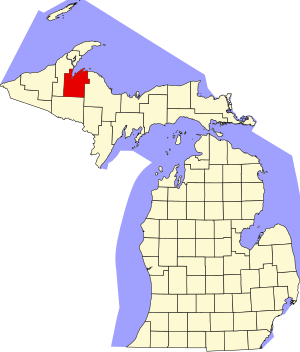Baraga County, Michigan
Baraga County | |
|---|---|
 Location within the U.S. state of Michigan | |
 Michigan's location within the U.S. | |
| Coordinates: 46°43′N 88°20′W / 46.72°N 88.34°W | |
| Country | |
| State | |
| Founded | February 19, 1875 [1] |
| Seat | L'Anse |
| Area | |
• Total | 1,069 sq mi (2,770 km2) |
| • Land | 904 sq mi (2,340 km2) |
| • Water | 165 sq mi (430 km2) 15.24% |
| Population (2000) | |
• Total | 8,746 |
| • Density | 10/sq mi (4/km2) |
| Website | www |
Baraga County is a county in the U.S. state of Michigan, named after Bishop Frederic Baraga. As of the 2000 census, the population was 8,746. The county seat is L'Anse.Template:GR The L'Anse Indian Reservation of the Ojibwa is located within the county.
Geography
According to the U.S. Census Bureau, the county has a total area of 1,069 square miles (2,768 km²), of which, 904 square miles (2,341 km²) of it is land and 165 square miles (427 km²) of it (15.42%) is water. The county is located in the state's Upper Peninsula on the shore of Lake Superior, at the southeast base of the Keweenaw Peninsula. The villages of Baraga and L'Anse are located at the base of Lake Superior's Keweenaw Bay. Point Abbaye projects from the county, creating the Huron Bay. Mount Arvon is the highest point in Michigan at 1,979 feet (603 m).
Highways
US Highways
Michigan State Trunklines
Adjacent counties
- Marquette County (east)
- Iron County (south)
- Houghton County (west)
National protected areas
- Keweenaw National Historical Park (part)
- Ottawa National Forest (part)
Demographics
As of the 2000 census, [1] there were 8,746 people, 3,353 households, and 2,223 families residing in the county. The population density was 10 people per square mile (4/km²). There were 4,631 housing units at an average density of 5 per square mile (2/km²). The racial makeup of the county was 78.61% White, 4.99% Black or African American, 12.04% Native American, 0.27% Asian, 0.01% Pacific Islander, 0.26% from other races, and 3.82% from two or more races. 0.93% of the population were Hispanic or Latino of any race. 29.5% were of Finnish, 9.9% German and 8.6% French ancestry according to Census 2000. 92.5% spoke English, 4.9% Finnish and 1.7% Spanish as their first language.
There were 3,353 households out of which 29.10% had children under the age of 18 living with them, 51.50% were married couples living together, 10.10% had a female householder with no husband present, and 33.70% were non-families. 29.50% of all households were made up of individuals and 13.60% had someone living alone who was 65 years of age or older. The average household size was 2.37 and the average family size was 2.93.
In the county the population was spread out with 22.90% under the age of 18, 7.30% from 18 to 24, 28.40% from 25 to 44, 25.10% from 45 to 64, and 16.30% who were 65 years of age or older. The median age was 39 years. For every 100 females there were 111.00 males. For every 100 females age 18 and over, there were 114.30 males.
The median income for a household in the county was $33,673, and the median income for a family was $42,500. Males had a median income of $32,138 versus $22,030 for females. The per capita income for the county was $15,860. About 7.20% of families and 11.10% of the population were below the poverty line, including 13.50% of those under age 18 and 10.30% of those age 65 or over.
Government
The county government operates the jail, maintains rural roads, operates the major local courts, keeps files of deeds and mortgages, maintains vital records, administers public health regulations, and participates with the state in the provision of welfare and other social services. The county board of commissioners controls the budget but has only limited authority to make laws or ordinances. In Michigan, most local government functions — police and fire, building and zoning, tax assessment, street maintenance, etc. — are the responsibility of individual cities and townships.
Baraga County elected officials
- Prosecuting Attorney: Joseph P. O'Leary
- Sheriff: Robert Teddy
- County Clerk/Register of Deeds: Wendy Goodreau
- County Treasurer: Anne Koski
- Mine Inspector:
Baraga County Commissioners
- District 1: Gale Eilola
- District 2: Mike Koskinen
- District 3: Paul Tesanovich
- District 4: William Menge
- DIstrict 5: Open Seat Till Appointment of May 5th 2009 Special Election
(information as of February 2009
Cities, villages, and townships
Template:Multicol Cities
- none
Villages
Template:Multicol-break Unincorporated
Townships
References
- ^ Statistical profile of Baraga County, Michigan, United States Census Bureau, Census 2000

